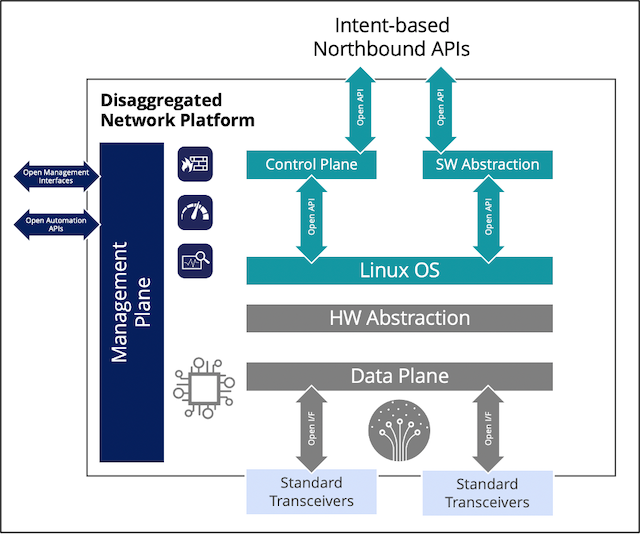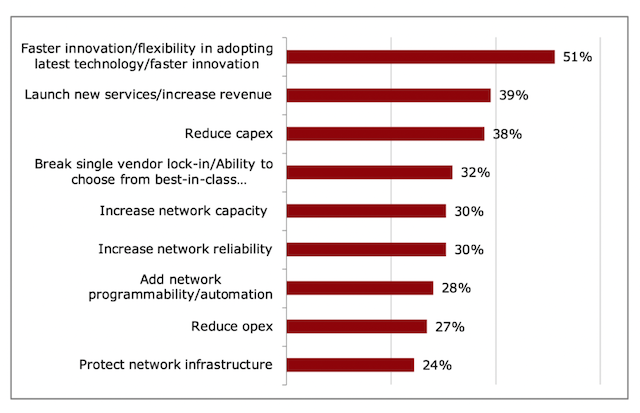Tech’s trend of openness and inclusivity is thriving, and it has extended to network operations. With network disaggregation — migrating a closed system provided by a single vendor to a decoupled system with open components — businesses are breaking the mold of rigid operating systems and discovering a level of flexibility and sustainability needed to compete in today’s environment.
We’re witnessing a change in the foundation of our hardware and silicon networking solutions, leading to a democratization of technology that’s both exciting and revolutionary.
We’re witnessing a change in the foundation of our hardware and silicon networking solutions, leading to a democratization of technology that’s both exciting and revolutionary. In the age of the modern 4G and 5G networks, waning are the days where operators are tethered to preexisting infrastructure and the monopoly of a vendor’s legacy silicon, management options and embedded software.
With the advent of network disaggregation, operators are discovering the benefits, including control over the pace of innovations, increased choices, continuity in business operations and access to broad ecosystems.
Here, we’ll give an overview of key benefits gained from network disaggregation and discuss the initial steps to begin the process.
Common NOS Platform Explained
Anyone that’s worked in an office is familiar with a network operating system (NOS). It’s the system that allows your device — laptop, desktop, printer, etc. — to manage the operations and communicate with other devices. Historically, however, these systems lacked the “common” attribute, making them closed, rigid systems that required proprietary software or hardware to join.
With network disaggregation and the creation of common network operating systems (like IP Infusion’s OcNOS®), old networks are transitioning to systems designed around modular building blocks that can readily integrate through open interfaces and application programming interfaces (APIs). This gives operators the ability to tailor network solutions to any problem at hand, saving time and money. Sound like the cloud? That’s because the cloud is the natural evolution of network disaggregation.
A common software platform supports a wide range of silicon, interfaces, and software by leveraging open source, open standards, and open APIs. Such unprecedented choice allows operators to adopt new products, standards, and technologies at their own pace and not be forced by incumbent vendors.
Over the past decade, hyperscale cloud operators — “hyperscale” being the ability to quickly scale up to meet network demand — have embraced disaggregation to disrupt vertically integrated networking in order to achieve their objectives. This led to the software-defined networking (SDN) movement, motivating unprecedented change for the entire networking industry.
The SDN technology allowed businesses to break free from the suite of devices available through their network’s original equipment manufacturer (OEM) — which was designed around the OEM proprietary ASIC structure — and allow interoperability with open solutions from other suppliers. With the introduction of the 5G network, this inclusivity is essential now more than ever.
A common software platform supports a wide range of silicon, interfaces, and software by leveraging open source, open standards, and open APIs. Such unprecedented choice allows operators to adopt new products, standards, and technologies at their own pace and not be forced by incumbent vendors.
For instance, if a task arises where 40 Gbps is sufficient, there is no need to upgrade to 100 Gbps. In previous systems, operators would be at the mercy of vendors to adopt the full 100 Gbps, but no more. Gone are the days of stratified feature sets that are closely coupled to high-end hardware.
Ultimately, the common NOS platform catalyzes a paradigm shift from hardware-centric to software-centric networking.

Shown above is the Disaggregated NOS Platform architecture is fundamental to network disaggregation.
The Value of a Common NOS Platform
As mentioned earlier, there are myriad benefits to employing a common network operating system. From cost to agility, businesses are finding that this open approach to networking invites opportunity, innovation and sustainability.
Unprecedented choice. Common network operating system platforms empower operators to take the reins when it comes to new advanced technology implementation. Not only are they now free to work outside the box of a traditional network and the proprietary software that comes from a singular vendor, but they’re also free to implement new updates, customizations and solutions on their timeframe.
Increased Agility. Like the breakthrough in choice, operators on a common network operating system can adapt swiftly to meet the demands of data use or work quickly to address individual problems with tailored solutions.
Business Continuity. With an open network, there is no vendor lock-in. Businesses are free to choose vendors of their preference. Breaking down the walls of the traditional networking system can bring continuity across departments where rigid, incompatible systems may have previously existed.
Innovation. Disaggregation naturally motivates an inclusive, highly competitive and market-driven open ecosystem, which is important for any business to maintain a competitive edge.
Cost Sustainability. The bottom line always factors in a big way, and network disaggregation to a common network operating system is no different. Whether you’re on the capital or operation expenditure side of the ledger, common network operating systems will benefit both.

Shown above are the top factors motivating organizations to adopt disaggregated networking solutions, based on a global operator survey. Download the in-depth Heavy Reading report here.
Adopting the Common NOS Platform to Benefit Your Business
Migrating from legacy networks to contemporary services can feel like a monumental undertaking — and it is — but having a uniquely experienced partner with a track record of network innovation mitigates the risk and transitions businesses into a new era of computing.
IP Infusion has been at the forefront of open networking from its inception. IP Infusion innovated open-source routing, driving every major project including Zebra, Quagga and the Linux Foundation Networking OpenSwitch/OPx projects.
As a NOS innovator for more than two decades, IP Infusion has realized the vision for network disaggregation through a proven set of solutions addressing a wide range of use cases. IP Infusion’s OcNOS was among the first common NOS platforms designed for carrier-grade disaggregation.
OcNOS has been deployed across a broad range of open and highly scalable hardware platforms to address a wide range of use cases. Mobile operators around the globe have deployed OcNOS to disaggregate the 4G and 5G mobile networks, including Access, Mobile xHaul (fronthaul, midhaul and backhaul), Transport, Mobile Core, and Carrier Ethernet segments.
While modularity, ease of integration, and openness are essential. The IP Infusion Control Plane realizes the promise for the common NOS platform. By supporting a rich set of Layer 2-3 protocols on par with incumbent vendors, OcNOS enables migration from legacy networks to contemporary services. Enhanced support for timing and synchronization, high-availability, and additional value-added communications features allow a common OcNOS platform to support a range of use cases spanning orders of magnitude of bandwidth.
Closing Thoughts
The common NOS platform is the centerpiece of network disaggregation, unleashing unprecedented agility, scale, and functionality, and ushering in software-driven services. Unlike open-source networking, which imposes the burden of integration and support on the operator, common NOS platforms are available on a range of pre-qualified hardware platforms suitable for a diverse set of use cases.
IP Infusion operationalizes the common NOS platform and, hence, disaggregation while mitigating the risks along the way. Please contact IP Infusion to learn more or for additional details click here.
About the Author
As Chief Sales Officer, Tom Savoie leads IP Infusion’s global sales force. With 25 years of experience in networking and software domains, Tom is deeply passionate about the disruption of proprietary, closed, complex, and costly legacy network systems. He has focused his career on disaggregation, openness, and virtualization since the very beginnings of the white box / NOS, SDN, and NFV movements. Before joining IP Infusion, Tom held roles at Dell as open networking principal for U.S. Network Operators and Intel as vice president of sales for Wind River.

